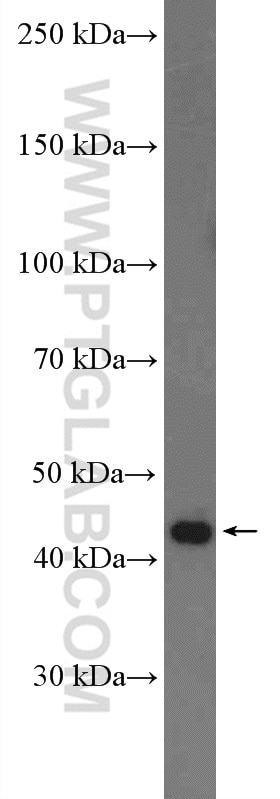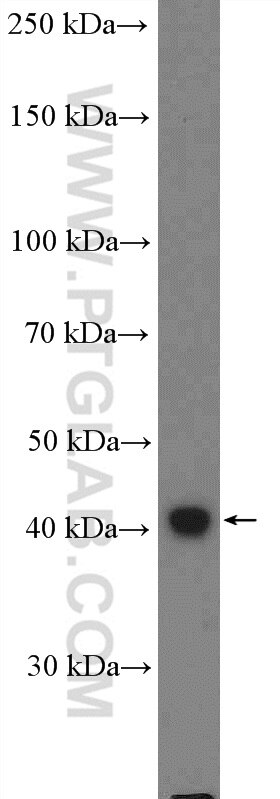Anticorps Polyclonal de lapin anti-SH3GL1
SH3GL1 Polyclonal Antibody for WB, ELISA
Hôte / Isotype
Lapin / IgG
Réactivité testée
Humain, rat, souris
Applications
WB, IF, ELISA
Conjugaison
Non conjugué
N° de cat : 27014-1-AP
Synonymes
Galerie de données de validation
Applications testées
| Résultats positifs en WB | tissu cérébral de rat, tissu cérébral de souris |
Dilution recommandée
| Application | Dilution |
|---|---|
| Western Blot (WB) | WB : 1:1000-1:4000 |
| It is recommended that this reagent should be titrated in each testing system to obtain optimal results. | |
| Sample-dependent, check data in validation data gallery | |
Applications publiées
| WB | See 1 publications below |
| IF | See 1 publications below |
Informations sur le produit
27014-1-AP cible SH3GL1 dans les applications de WB, IF, ELISA et montre une réactivité avec des échantillons Humain, rat, souris
| Réactivité | Humain, rat, souris |
| Réactivité citée | souris |
| Hôte / Isotype | Lapin / IgG |
| Clonalité | Polyclonal |
| Type | Anticorps |
| Immunogène | SH3GL1 Protéine recombinante Ag25550 |
| Nom complet | SH3-domain GRB2-like 1 |
| Masse moléculaire calculée | 41 kDa |
| Poids moléculaire observé | 41-43 kDa |
| Numéro d’acquisition GenBank | BC001270 |
| Symbole du gène | SH3GL1 |
| Identification du gène (NCBI) | 6455 |
| Conjugaison | Non conjugué |
| Forme | Liquide |
| Méthode de purification | Purification par affinité contre l'antigène |
| Tampon de stockage | PBS with 0.02% sodium azide and 50% glycerol |
| Conditions de stockage | Stocker à -20°C. Stable pendant un an après l'expédition. L'aliquotage n'est pas nécessaire pour le stockage à -20oC Les 20ul contiennent 0,1% de BSA. |
Protocole
| Product Specific Protocols | |
|---|---|
| WB protocol for SH3GL1 antibody 27014-1-AP | Download protocol |
| Standard Protocols | |
|---|---|
| Click here to view our Standard Protocols |
Publications
| Species | Application | Title |
|---|---|---|
J Cell Sci Tubular microdomains of Rab7-positive endosomes retrieve TrkA, a mechanism disrupted in Charcot-Marie-Tooth disease 2B. | ||



